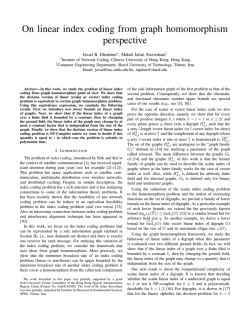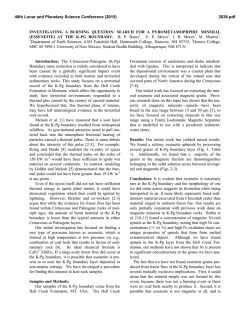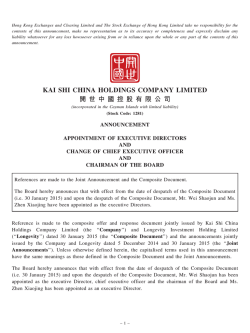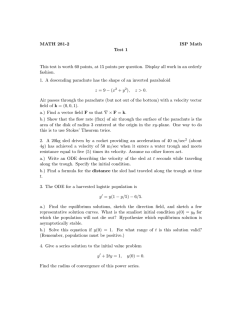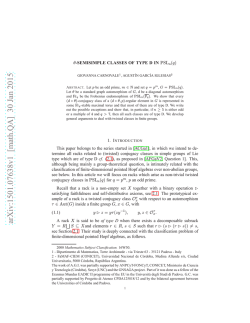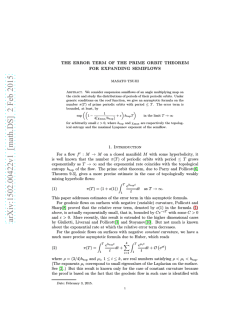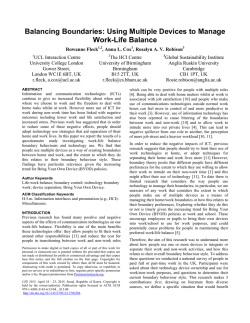
SOLUTIONS FOR THE CAHN-HILLIARD EQUATION WITH
SOLUTIONS FOR THE CAHN-HILLIARD EQUATION
WITH MANY BOUNDARY SPIKE LAYERS
JUNCHENG WEI AND MATTHIAS WINTER
Abstract. In this paper we construct new classes of stationary solutions
for the Cahn-Hilliard equation by a novel approach.
One of the results is as follows: Given a positive integer K and a (not
necessarily nondegenerate) local minimum point of the mean curvature
of the boundary then there are boundary K–spike solutions whose peaks
all approach this point. This implies that for any smooth and bounded
domain there exist boundary K–spike solutions.
The central ingredient of our analysis is the novel derivation and exploitation of a reduction of the energy to finite dimensions (Lemma 3.5),
where the variables are closely related to the peak loations.
1. Introduction
The Cahn-Hilliard equation [7] was originally derived from the Helmholtz
free energy of an isotropic two-component solid and can be written as follows:
1
[F (u(x)) + 2 |∇u(x)|2 ]dx.
2
Ω
It is a well-accepted and widely studied macroscopic model for phase separation. Here Ω ⊂ RN is the smooth and bounded region occupied by the
E(u) =
body, u(x) is an order parameter typically representing the concentration
of one of the components. Furthermore, F (u) is the free energy density of
a corresponding homogeneous solid which has a double well structure the
prototype being F (u) = (1 − u2 )2 since we consider low temperatures. The
constant describes the range of intermolecular forces; the gradient term
models spatial fluctuations.
We assume conservation of the order parameter, i.e. there exists u with
1 −1 < u < 1 such that u = |Ω|
Ω udx. Therefore, a stationary solution of
1991 Mathematics Subject Classification. Primary 35B40, 35B45; Secondary 35J40.
Key words and phrases. Phase Transition, Nonlinear Elliptic Equations.
1
2
JUNCHENG WEI AND MATTHIAS WINTER
E(u) under the conservation constraint u =
⎧
2
⎪
⎨ ∆u − f (u) = λ
⎪
⎩
1 |Ω| Ω
udx satisfies
in Ω,
∂u
∂ν
(1.1)
=0
on ∂Ω,
u
=
u|Ω|,
Ω
where f (u) = F (u) and λ is a constant.
In this paper we are concerned with solutions of (1.1) which contain spike
layers. The one dimensional case was studied by Novick-Cohen and Segal
[33], Novick-Cohen and Peletier [32], Bates and Fife [6], Grinfeld and NovickCohen [13], [14].
In [44] we constructed a boundary spike layer solution to (1.1) whose peak
approaches a given nondegenerate critical point of the mean curvature of the
boundary assuming that u lies in the metastable region, i.e. f (u) > 0, for
dimensions N ≥ 2 and << 1.
Under the same assumptions in [45] we constructed a solution to (1.1)
with many boundary spike layers whose peaks are each located near different
nondegenerate critical points of the mean curvature of the boundary.
In both [44] and [45] we reduce the problem to finite dimensions and use
a fixed–point techique to obtain solutions. In this paper our approach is
reducing the energy to finite dimensions and finding extrema for it instead.
A new analysis is required. Although many of the estimates required for this
analysis are the same as in [17] some major differences are needed to deal
with the conservation constraint. These occur in particular in Lemma 3.6
and in Section 5.
The existence of spike layer solutions as well as their profile and the location of the peaks for the semilinear Neumann problem
ε2 ∆u − u + up = 0
=0
u > 0 in Ω, ∂u
∂ν
in
on
Ω
∂Ω,
for subcritical exponents p which arises as a model in various areas of applied
science such as chemotaxis, pattern formation, chemical reactor theory, etc.
has been studied by Lin, Ni, Pan, and Takagi [21, 26, 27, 28] and lately
by Gui, Wei, and Winter [15], [43], [17], and [20]. For the critical case
p = (N + 2)/(N − 2) similar results have obtained for example in [1], [2],
[3], [16], [36], [37], [38], [42]. The corresponding Dirichlet problem in the
CAHN-HILLIARD EQUATION
3
subcritical case was first investigated by by Ni and Wei [30]. for the Dirichlet
problem. However, they do not have the conservation constraint and the
nonlinearity is simpler than here.
Naturally these stationary solutions are essential for the understanding of
the dynamics of the corresponding evolution process.
Other important features of the Cahn-Hilliard equation with physical relevance are spinodal decomposition and pattern formation. In this respect
see the recent work of Kielh¨ofer [18] and Maier-Paape and Wanner [23], [24]
and the references therein. The existence of stationary interface solutions
has first been proved my Modica [25]. See also the works of Luckhaus and
Modica [22] for the geometrical interpretation of the Lagrange multiplier
λ , Niethammer [31] for the radially symmetric case. See also Kohn and
Sternberg [19], and Chen and Kowalczyk [8].
The dynamics of interface solutions has been studied extensively, see for
example [39], [5], [4], [9], [10].
The attractor has been investigated for example in [14] and [41].
u) > 0.
Henceforth, we assume that f (¯
Before stating our main result we make the following transformation.
v = u − u,
g(v) = −f (u) + f (u − v).
Rewrite
g (0) = −m, g(v) = −mv + h(v).
Then equation (1.1) becomes
2
1 ∆v − mv + h(v) − |Ω|
Ω h(v) = 0
∂v
∂ν
=0
in Ω,
on ∂Ω.
To accommodate more general g we assume that
(g1) g(0) = 0, g (0) = −m < 0.
(g2) g ∈ C 2 (R+ ), g(v) = −mv + h(v), where h satisfies
h(v) = O(|v|p1 ), h (v) = O(|v|p2 −1 ) as |v| → ∞
(1.2)
4
JUNCHENG WEI AND MATTHIAS WINTER
for some 1 < p1 , p2 <
there exists 1 < p3 <
N +4
N −4 +
N +4
N −4 +
|h (v + φ) − h (v)| ≤
= ∞ if N ≤ 4,
N +4
N −4
if N ≥ 5 ;
such that
C|φ|p3 −1 if p3 > 2,
C(|φ| + |φ|p3 −1 ) if p3 ≤ 2.
(g3) The equation
⎧
⎪
V − mV + h(V ) = 0
⎪
⎪
⎨
in RN ,
V > 0, V (0) = maxn V (z),
⎪
⎪
⎪
⎩V → 0
at ∞
(1.3)
z∈R
has a unique solution V (y) (by the results of [12], V is radial, i.e. V =
V (r) and V < 0 for r = |y| = 0). Furthermore, V is nondegenerate,
namely the operator
L := + g (V )
(1.4)
is invertible in the space Hr2 (RN ) := u = u(|y|) ∈ H 2 (RN ) .
Remark: Assuming F (u) = (1 − u2 )2 (i.e. f (u) = −4u(1 − u2 )) and f (¯
u) >
0 by changing F at infinity the Cahn-Hilliard equation satisfies conditions
(g1) – (g3). See [44]. In [44] it is shown that without loss of generality
we can assume that h and its first two derivatives are bounded continouous
functions on the real line. For simpicity, we make this assumption for the
rest of the paper.
Let Γ ⊂ ∂Ω be a relatively open set such that
min κ(P ) > min κ(P ),
P ∈∂Γ
P ∈Γ
(1.5)
where κ(P ) is the mean curvature of ∂Ω at the point P .
Our main result can be stated as follows.
Theorem 1.1. Assume that condition (1.5) holds. Let g satisfy assumptions (g1)-(g3). Then for ε sufficiently small problem (1.2) has a solution vε which possesses exactly K local maximum points Qε1 , ..., QK with
Q = (Q1 , ..., QK ) ∈ Γ × ... × Γ.
|Q −Q |
Moreover κ(Qi ) → minP ∈Γ κ(P ), V ( k l ) → 0, i, k, l = 1, ..., K, k = l as
→ 0. Furthermore, there exists a real constant v∞ and positive constants
CAHN-HILLIARD EQUATION
a, b such that v (x) → v∞ as → 0 and
|v (x) −
v∞ |
5
b mini=1,...,K (|x − Qi |)
≤ aexp −
.
(1.6)
Theorem 1.1 can be derived from a more general theorem which is as
follows.
Theorem 1.2. Let Γi , i = 1, ..., K be relatively open sets in ∂Ω such that
min κ(P ) > min κ(P ), i = 1, ..., K.
P ∈∂Γi
P ∈Γi
Let g satisfy assumptions (g1)-(g3).
Then for ε sufficiently small prob-
lem (1.2) has a solution vε which possesses exactly K local maximum points
Qε1 , ..., QK with Q = (Q1 , ..., QK ) ∈ Γ1 × ... × ΓK . Moreover κ(Qi ) →
|Q −Q |
minP ∈Γi κ(P ), V ( k l ) → 0, i, k, l = 1, ..., K, k = l as → 0. Furthermore, there exists a real constant v∞ and positive constants a, b such that
v (x) → v∞ as → 0 and
b mini=1,...,K (|x − Qi |)
).
(1.7)
More details about the asymptotic behaviour of v can be found in the
proof of Theorem 1.2.
|v (x) − v∞ | ≤ aexp(−
We have the following interesting corollary.
Corollary 1.3. Let g satisfy assumptions (g1)-(g3). Then for any smooth
and bounded domain and any fixed positive integer K ∈ Z, there always
exists a boundary K-peak solution of (1.1) if is small enough.
Theorem 1.1 is the first result about the existence of boundary K-spike
solutions for problem (1.2) for any positive integer K in any smooth bounded
domain. Note that for a strict local minimum point of κ(P ) (i.e. there
exists a relatively open set Γ ⊂ ∂Ω with P ∈ Γ such that κ(Q) > κ(P ) for
all Q ∈ Γ) the boundary K-spike solutions can be chosen such that their
peaks approach the same point on the boundary. Intuitively speaking, the
boundary spikes attract one another. This is in balance with “forces” coming
from the curvature of the boundary which prevent the spikes from moving
closer towards one another and towards the strict local minimum point of
κ(P ).
6
JUNCHENG WEI AND MATTHIAS WINTER
It seems that this new phenomenon cannot occur at a local maximum
point of κ(P ).
In this paper we study local minimum or maximum points of the mean
curvature of the boundary without assuming their nondegeneracy. Instead
we only need the global condition (1.5) which can be genuinely weaker in
many cases. To our knowledge, this was not possible in all previous works.
Theorem 1.2 is the main result in this paper. To introduce the most
important idea of the proof of Theorem 1.2, we need to give some notations
and definitions first.
For our approach it is essential to note that v is a solution of (1.2) if and
only if v is a critical point of
2 m 2 2
|∇v| +
v − H(v),
J (v) =
2 Ω
2 Ω
Ω
where
H(v) =
v
0
1
h(s)ds, v ∈ X = {v ∈ H (Ω)|
Ω
v = 0}.
Note that the conservation constraint
Ω
v=0
(1.8)
contributes the Lagrange multiplier λ in (1.1). Recall on the other hand that
for solutions of (1.2) equation (1.8) does not have to be assumed a priori but
∂v
= 0 at ∂Ω}.
follows automatically for all solutions in {v ∈ H 2 (Ω) : ∂ν
We start our construction by finding good approximating functions for
the solutions. Our approach is by using a projection technique to obtain
appropriate functions in the space X. Let V be the unique solution of (1.3).
It is known (see [12]) that V is radially symmetric, decreasing and
lim V (y)e
|y|→∞
√
m|y|
|y|
N −1
2
= c0 > 0.
Let P ∈ Ω, Ω,P := {y|y + P ∈ Ω} and Ω := {y|y ∈ Ω}.
For any smooth domain U ⊂ RN we define a function u = PU V as the
unique solution of
⎧
⎨∆u − mu + h(V ) = 0 in U,
⎩ ∂u = 0 on ∂U.
∂ν
CAHN-HILLIARD EQUATION
7
Let η > 0 be a small number. Let Γi be as in Theorem 1.2. Set
|Pk − Pl |
Λ = {P = (P1 , ..., PK ) ∈ Γ1 ×...×ΓK , V (
) < η, k, l = 1, ..., K, k = l}.
Fix P = (P1 , P2 , ..., PK ) ∈ Λ. We set
Pi
Pi
Vi (y) = V (y − ), P Vi (y) = PΩ,Pi V (y − ), y ∈ Ω ,
1 P Vi (y) dy,
P0 Vi (y) = P Vi (y) −
|Ω | Ω
w,P =
K
i=1
P0 Vi ,
v = w,P + Φ,P ∈ H 2 (Ω ),
where
∂Φ
Φ dy = 0}
= 0 on ∂Ω ,
∂ν
Ω
is still unknown. Finally, we introduce
∂P0 Vi
K,P = C,P = span{
, i = 1, ..., K, j = 1, ..., N − 1}
∂τPi,ij
Φ,P ∈ {Φ ∈ H 2 (Ω ) :
to denote the approximate kernel and cokernel of the operator obtained from
linearizing (1.2) at w,P , respectively, where τPi,ij are the (N − 1) tangential
derivatives at Pi (without loss of generality we may assume that the inward
normal vector at Pi is eN ). We denote τPi,ij as τPi,j in the rest of the paper.
We first solve for Φ,P such that
⊥
,
v ∈ K,P
1 ∆v − mv + h(v ) −
h(v ) dy ∈ C,P
|Ω | Ω
using the Liapunov-Schmidt reduction method. This method evolves from
that of [11], [34], and [35] on the semi-classical (i.e. for small parameter h)
solution of the nonlinear Schr¨odinger equation
2
h
(1.9)
∆U − (V − E)U + U p = 0
2
in RN , where V is a potential function and E is a real constant. The method
of Liapunov-Schmidt reduction was used in [11], [34] and [35] to construct
solutions of (1.9) close to nondegenerate critical points of V for h sufficiently
small.
8
JUNCHENG WEI AND MATTHIAS WINTER
Then we show that Φ,P is C 1 in P. Now we have developed all the tools
to introduce the novel function
K
M (P) = J (
i=1
P0 Vi + Φ,P ).
(1.10)
That means we have reduced the energy J to finite dimensions, where the
variables are closely related to the location of the peaks. A large part of the
paper is devoted to deriving an explicit expression for M (P).
We maximize M (P) over Λ. Condition (1.5) ensures that M (P) attains
its maximum inside Λ. We show that the resulting solution has the properties
of Theorem 1.2.
Throughout this paper, unless otherwise stated, the letter C will always
denote various generic constants which are independent of , for sufficiently
small; δ > 0 is a very small number; o(1) means |o(1)| → 0 as → 0.
The paper is organized as follows. Notation, preliminaries and some useful estimates are explained in Section 2. Section 3 contains the setup of our
problem and we solve (1.2) up to approximate kernel and cokernel, respectively. We introduce and solve a finite-dimensional optimization problem in
Section 4. Finally, in Section 5, we show that the solution to the maximizing problem is indeed a solution of (1.2) and satisfies all the properties of
Theorem 1.2.
Acknowledgement. This research is supported by Stiftung Volkswagenwerk (RiP-program at Mathematisches Forschungsinstitut Oberwolfach).
We would like to thank everyone at the institute for offering their kind hospitality and providing an excellent research environment during our stay. The
research of the first author is supported by an Earmarked Grant from RGC
of Hong Kong.
We thank the referee for valuable suggestions.
2. Technical Analysis
In this section we introduce a projection and derive some useful estimates.
Finally we will prove some lemmas which will be important in deriving an
explicit expression for M (P) as defined in (1.10). Propositions 2.1 and 2.2
CAHN-HILLIARD EQUATION
9
as well as Lemma 2.3 are from [44] and are presented here for the convenience
of the reader.
Throughout the paper we shall use the letter C to denote a generic positive
N
= {(x , xN )|xN >
constant which may vary from term to term. We denote R+
0}, where x = (x1 , . . . , xN −1 ). Let V be the unique solution of (1.3).
Set
1
2
2
(|∇V | + mV ) −
H(V ).
I(V ) =
2 RN
RN
Let P ∈ ∂Ω. Then, since ∂Ω is smooth, there exists R0 > 0 such that
for |x − P | < R0 , ∂Ω can be represented by the graph of a smooth function
ρ(x − P ), where ρ(0) = 0, ∇ρ(0) = 0. The mean curvature of ∂Ω at P is
κ(P ) =
N −1
1
N −1
i=1
ρii (0), where
ρi =
∂ρ
,
∂xi
i = 1, . . . , N − 1.
|α|
Here we use ρα to denote the multiple differentiation ∂∂xαρ for α = (α1 , . . . , αN −1 ),
N −1
where αi ∈ {0, 1, . . . } for i = 1, . . . , N − 1 and |α| = i=1
αi . We denote
v
2 = −N
Ω
[2 |∇v|2 + mv 2 ].
For x ∈ Ω0 set now
yi = xi − Pi , i = 1, . . . , N − 1,
yN = xN − PN − ρ(x1 − P1 , . . . , xN −1 − PN −1 ).
(2.1)
Furthermore, for x ∈ Ω0 we introduce the transformation
Ti (x) = xi , i = 1, . . . , N − 1,
TN (x) = xN − PN − ρ(x1 − P1 , . . . , xN −1 − PN −1 ).
Note that then
(2.2)
1
y = T (x).
Then we have
Proposition 2.1. Let χ(x) be a smooth cutoff function such that χ(x) =
1, x ∈ B(P, R0 − δ) and χ(x) = 0 for x ∈ B(P, R0 )C (for a positive and
sufficiently small number δ.) Then
2
V − PΩ,P V
x − P = v1 (y)χ(x − P ) + (v2 (y)χ(x − P ) + v3 (y)χ(x − P )) + 3 Ψ,P (x),
10
JUNCHENG WEI AND MATTHIAS WINTER
where v1 is the unique solution of
N
∆v − mv = 0
in R+
,
∂v
V 1 N −1
=
−
ρ
(0)y
i yj
i,j=1 ij
∂yN
|y| 2
(2.3)
N
on ∂R+
,
; v2 is the unique
V is the radial derivative of V , i.e. V = Vr (r), r = x−P
solution of
⎧
⎨ ∆v − mv − 2 N −1 ρij (0)yi ∂ 2 v1 = 0
i,j=1
∂yj ∂yN
N −1
N
⎩ ∂v = i,j=1
ρij (0)yi ∂v1
on ∂R+
;
∂yN
N
in R+
,
(2.4)
∂yj
v3 is the unique solution of
N
∆v − mv = 0
in R+
,
N −1
∂v
V 1
= − |y| 3 i,j,k=1 ρijk (0)yi yj yk
∂yN
(2.5)
N
on ∂R+
and
Ψ,P ≤ C.
Proof. A proof can be found in [44].
Note that v1 , v2 are even functions in y = (y1 , ..., yN −1 ) and v3 is an odd
function in y = (y1 , ..., yN −1 ) (i.e. v1 (y , yN ) = v1 (−y , yN ), v3 (y , yN ) =
−v3 (−y , yN )). Moreover, it is easy to see that |v1 |, |v2 |, |v3 | ≤ Ce−µ|y| for
√
some 0 < µ < m.
We next analyze ∂/∂τPj PΩ,P V x−P
for sufficiently small x. Because we
choose the coordinate system as explained on page 7, we have ∂/∂τPj =
∂/∂Pj .
Proposition 2.2.
∂PΩ,P V x − P ∂V
−
= w1 (y)χ(x − P ) + w2 (x),
∂τPj
∂τPj
where w1 is the unique solution of
N
∆v − mv =
in R+
,
0
∂v
1 V
V N −1
= − 2 |y|2 − |y|3
k,l=1 ρkl (0)yk yl yj −
∂yN
V
|y|
N −1
k=1
N
ρjk (0)yk on ∂R+
.
(2.6)
and
w2 ≤ C.
CAHN-HILLIARD EQUATION
11
Proof. A proof can be found in [44].
Note that |w1 | ≤ C exp(−µ|y|) and |w2 | ≤ C exp(−µ|y|) for some µ <
and w1 is an odd function in y .
√
m
Finally, let
L0 = ∆ − m + h (V ).
We have
Lemma 2.3.
Ker(L0 ) ∩
N
HN2 (R+
)
∂V
∂V
= span
,... ,
,
∂y1
∂yN −1
∂u
N
N
N
where HN2 (R+
) = {u ∈ H 2 (R+
), ∂y
= 0 on ∂R+
}.
N
Proof. See Lemma 4.2 in [28].
The next lemma is the key result in this section. Its proof is similar but
differs at a crucial points from the one in [17]. We indicate this difference.
Lemma 2.4. For any P = (P1 , ..., PK ) ∈ Λ and sufficiently small
K
J (
−
i=1
P0 Vi ) = N [
K
1 |Pk − Pl |
(γkl + o(1))V (
) + o()],
2 k,l=1,k=l
where
and γkl = γlk ∈ Σ for
(2.7)
1 |∇V |2 |y |2 dy β1 =
N + 1 RN −1
Σ=
K
K
I(V ) − (β1 + o(1))
κ(Pi )
2
i=1
N
R+
h(V (y))e
√
m<b,y>
N
dy | b ∈ R , |b| = 1 .
l|
Furthermore, if V ( |Pk −P
) = η, we have γkl ∈ Σ1 , where
Σ1 =
N
R+
h(V (y))e
√
m<b,y>
dy | b = (b1 , . . . , bN ) ∈ R , bN = 0, |b| = 1 .
K
Proof. In [17] we calculated J (
Note that
J (P0 V ) − J (P V ) = N
Ω
N
i=1
K
P Vi ). Now we need J (
i=1
P0 Vi ).
m
|P0 V |2 − |P V |2 − (H(P0 V ) − H(P V ))
2
12
JUNCHENG WEI AND MATTHIAS WINTER
= O(2N )
and
2
J (
i=1
2
P0 Vi ) − J(
i=1
P Vi ) = 2
−(H(
i=1
N
⎡
Ω,P
2
P0 Vi ) − H(
i=1
2
2
m 2
⎣
|
P0 Vi | − |
P Vi |2
2
i=1
i=1
⎤
P Vi ))⎦ = O(2N ).
Using Lemma 2.8 of [17] the proof is completed.
3. Liapunov-Schmidt Reduction
In this section, we reduce problem (1.2) to finite dimensions by the LiapunovSchmidt method. We first introduce some notation.
∂v
X = {v ∈ H 2 (Ω )|
v = 0,
= 0 on ∂Ω },
∂ν
Ω
2
Y = {v ∈ L (Ω )|
Ω
v = 0.}
Define
1 h(v),
|Ω | Ω
for v ∈ X. Then solving equation (1.1) is equivalent to
S (v) = ∆v − mv + h(v) −
S (v) = 0, v ∈ X.
Fix P = (P1 , ..., PK ) ∈ Λ. To study (1.2) we first consider the linearized
operator
1 h (w,P )u,
L : u → ∆u − mu + h (w,P )u −
|Ω | Ω
Recall that w,P =
K
i=1
= span
X → Y.
P0 Vi . Choose approximate cokernel and kernel as
C,P = K,P
∂P0 Vi i = 1, . . . , K, j = 1, . . . , N − 1 ,
∂τP i,j
where (as in the introduction)
K,P ⊂ X
and C,P ⊂ Y.
CAHN-HILLIARD EQUATION
13
⊥
Let π,P denote the projection from Y onto C,P
. Our goal in this section
is to show that the equation
π,P ◦ S (w,P + Φ,P ) = 0
⊥
has a unique solution Φ,P ∈ K,P
if is small enough and P = (P1 , ..., PK ) ∈
Λ.
As a preparation in the following two propositions we show the invertibility
of the corresponding linearized operator.
Proposition 3.1. Let L,P = π,P ◦ L . There exist positive constants , λ
such that for all ∈ (0, ) and P = (P1 , . . . , PK ) ∈ Λ
L,P Φ
L2 (Ω ) ≥ λ
Φ
H 2 (Ω )
(3.1)
⊥
for all Φ ∈ K,P
.
Proposition 3.2. There exists a positive constant ˜ such that for all ∈
(0, ˜) and P = (P1 , . . . , PK ) ∈ Λ the map
⊥
⊥
L,P = π,P ◦ L : K,P
→ C,P
is surjective.
Proof of Propositions 3.1 and 3.2. We refer to [45] for proofs.
We are now in a position to solve the equation
π,P ◦ S (w,P + Φ,P ) = 0.
(3.2)
Since L,P |K,P
is invertible (call the inverse L−1
⊥
,P ) we can rewrite
Φ = −L−1
,P ◦ π,P ◦ S (w,P )
−L−1
,P ◦ π,P ◦ N,P (Φ)
+L−1
,P ◦ π,P ◦ H ,P (Φ)
≡ G,P (Φ),
where
N,P (Φ) = S (w,P + Φ)
−[S (w,P ) + S (w,P )Φ],
1 H ,P (Φ) =
h (w,P )Φ,
|Ω | Ω
(3.3)
14
JUNCHENG WEI AND MATTHIAS WINTER
and the operator G,P is defined by (3.3) for Φ ∈ HN2 (Ω ). We are going to
show that the operator G,P is a contraction on
2
B,δ ≡ {Φ ∈ H (Ω )|
Ω
Φ = 0, Φ
H 2 (Ω ) < δ}
if δ is small enough.
In fact we have the following lemma
Lemma 3.3. For sufficiently small, we have
N,P (Φ)
L2 (Ω ) ≤ C
Φ,P L2 (Ω ) ,
(3.4)
S (w,P )
L2 (Ω ) ≤ C,
(3.5)
|H ,P (Φ)| ≤ CN Φ
L2 (Ω ) .
(3.6)
Proof. (3.4) follows from the mean value theorem since h ∈ C 2 (R) and
h, h , h are bounded real functions.
(3.6) follows since
|H ,P (Φ)| ≤ C
1
Φ
L2 (Ω ) h (w,P )
L2 (Ω ) ≤ CN Φ
L2 (Ω ) .
|Ω |
The proof of (3.5) is the same as in [17].
Thus
G,P (Φ)
H 2 (Ω ) ≤ λ−1 (
π,P ◦ N,P (Φ)
L2 (Ω )
+
π,P ◦ S (w,P )
L2 (Ω ) + π,P ◦ H ,P (Φ)
L2 (Ω ) )
≤ λ−1 C(c(δ)δ + ),
where λ > 0 is independent of δ > 0 and c(δ) → 0 as δ → 0. Similarly we
show
G,P (Φ) − G,P (Φ )
H 2 (Ω ) ≤ λ−1 C(c(δ) + O(N ))
Φ − Φ H 2 (Ω )
if δ, are small enough and where c(δ) → 0 as δ → 0. Therefore G,P is a
contraction on Bδ . The existence of a fixed point Φ,P now follows from the
Contraction Mapping Principle and Φ,P is a solution of (3.3).
Because of
Φ,P H 2 (Ω ) ≤ λ−1 (
N,P (Φ,P )
L2 (Ω )
+
S (w,P )
L2 (Ω ) + H ,P (Φ,P )
L2 (Ω ) )
≤ λ−1 C(1 + c(δ)
Φ,P H 2 (Ω ) )
CAHN-HILLIARD EQUATION
15
we have
Φ,P H 2 (Ω ) ≤ C.
We have proved
Lemma 3.4. There exists > 0 such that for every (N +1)-tuple , P1 , . . . , PK
⊥
with 0 < < and P = (P1 , ..., PK ) ∈ Λ there is a unique Φ,P ∈ K,P
satisfying S (w,P + Φ,P ) ∈ C,P and
Φ,P H 2 (Ω ) ≤ C.
(3.7)
The next lemma is our main estimate.
Lemma 3.5. Let Φ,P be defined by Lemma 3.4. Then we have
J (w,P + Φ,P )
⎡
= N ⎣
(3.8)
K
K
κ(Pi )
I(V ) − β1 2
i=1
⎤
|Pk − Pl |
1
(γkl + o(1))V (
−
) + o()⎦,
2 k,l=1,...,K,k=l
where β1 and γkl are introduced in Lemma 2.4 and Lemma 2.5,respectively.
Proof.
In fact, for any P ∈ Λ, we have
−N J (w,P + Φ,P ) = −N J (w,P ) + g,P (Φ,P ) + O(
Φ,P 2H 2 (Ω ) ),
where
g,P (Φ,P )
=
=
K
(∇P0 Vi ∇Φ,P + mP0 Vi Φ,P ) −
Ω i=1
K
[
Ω i=1
K
≤
i=1
2
Ω
h(Vi ) − h(w,P )]Φ,P + O(N +1 )
h(Vi ) − h(w,P )
L2 (Ω ) Φ,P L2 (Ω )
≤ O( )
K
h(
i=1
P0 Vi )Φ,P
16
JUNCHENG WEI AND MATTHIAS WINTER
for N ≥ 2 by Lemma 3.3 and Lemma 3.4.
Estimate (3.8) now follows from Lemma 2.4 and Lemma 3.4.
Finally, we show that Φ,P is actually smooth in P.
Lemma 3.6. Let Φ,P be defined by Lemma 3.4. Then Φ,P ∈ C 1 in P.
Proof. Recall that Φ,P is a solution of the equation
π,P ◦ S (w,P + Φ,P ) = 0
(3.9)
such that
⊥
Φ,P ∈ K,P
.
(3.10)
∂P0 Vi
∂Pi,j
By definition we easily conclude that the functions
and
∂ 2 P0 Vi
∂τPi,j ∂τPi,k
are
C 1 in P. This implies that the projection π,P is C 1 in P. Applying ∂/∂τPi,j
gives
K
∂P0 Vi
∂Φ,P
+
π,P ◦ DS (w,P + Φ,P )
∂τPi,j
i=1 ∂τPi,j
+
∂π,P
◦ S (w,P + Φ,P ) = 0,
∂τPi,j
(3.11)
where
1 DS (w,P + Φ,P ) = ∆ − m + h (w,P + Φ,P ) −
h (w,P + Φ,P ).
|Ω | Ω
We decompose
where
∂Φ,P
∂τPi,j
∂Φ,P
∂τPi,j
1
into two parts:
∂Φ,P
=
∂τPi,j
1
∈ K,P and
∂Φ,P
∂τPi,j
∂Φ,P
∂τPi,j
2
∂Φ,P
+
∂τPi,j
1
,
2
⊥
∈ K,P
. We can easily conclude that
is continuous in P since
Ω
and
∂Φ,P
∂τPi,j
Φ,P
Ω
∂P0 Vk
= 0,
∂τPk,l
k = 1, ..., K,
l = 1, ..., N − 1
∂Φ,P ∂P0 Vk ∂ 2 P0 Vk
+
Φ,P
=0
∂τPi,j ∂τPk,l
∂τPi,j ∂τPk,l
Ω
k, i = 1, ..., K,
l, j = 1, ..., N − 1.
CAHN-HILLIARD EQUATION
We can rewrite equation (3.11) as
∂Φ,P
π,P ◦ DS (w,P + Φ,P ) (
)2
∂τPi,j
+π,P ◦ DS (w,P + Φ,P )
+
K
∂P0 Vi
i=1
∂τPi,j
17
∂Φ,P
+(
)1
∂τPi,j
∂π,P
◦ S (w,P + Φ,P ) = 0.
∂τPi,j
(3.12)
As in the proof of Propositions 3.1 and 3.2, we can show that the operator
π,P ◦ DS (w,P + Φ,P )
⊥
⊥
to C,P
. Then we can take the inverse of π,P ◦
is invertible from K,P
DS (w,P + Φ,P ) in the above equation and the inverse is continuous in
P.
∂Φ
∂π
∂P0 Vi
, ( ∂τP,P )1 ∈ K,P are continuous in P and so is ∂τP,P , we conclude
∂τPi,j
i,j
i,j
∂Φ
( ∂τP,P )2 is also continuous in P. This is equivalent to C 1 –dependence
Since
that
i,j
of Φ,P on P. The proof is finished.
4. The reduced problem: An Optimization Procedure
In this section, we study an optimization problem.
Fix P ∈ Λ. Let Φ,P be the solution given by Lemma 3.4. We define a
new functional
M (P) = J (w,P + Φ,P ) : Λ → R.
(4.1)
We shall prove
Proposition 4.1. For small, the optimization problem
max{M (P) : P ∈ Λ}
(4.2)
has a solution P ∈ Λ.
Proof. Since J (w,P + Φ,P ) is continuous in P, the optimization problem
has a solution. Let M (P ) be the maximum where P ∈ Λ. We claim that
P ∈ Λ.
18
JUNCHENG WEI AND MATTHIAS WINTER
In fact, for any P ∈ Λ, by Lemma 3.5, we have
⎡
M (P) = N ⎣
K
K
I(V ) − β1 ( κ(Pi ))
2
i=1
⎤
1
|Pk − Pl |
−
(γkl + o(1))V (
) + o()⎦.
2 k,l=1,...,K,k=l
Since M (P ) is the maximum, we have
β1
≤ β1
K
i=1
K
i=1
κ(Pi )
κ(Pi ) +
1 1
|Pk − Pl |
+
( γkl + o(1))V (
)
k=l 2
1 1
|Pk − Pl |
( γkl + o(1))V (
) + o(1)
k=l 2
(4.3)
for any P = (P1 , ..., PK ) ∈ Λ. Choose Pi such that κ(Pi ) → minP ∈Γi κ(P )
l| 1
for i = 1, 2, . . . , K and V ( |Pk −P
) → 0 for k = l. This implies that
β1
K
i=1
κ(Pi )
K
1 1
|Pk − Pl |
+
( γkl + o(1))V (
min κ(P ) + δ
) ≤ β1
P ∈Γi
k=l 2
i=1
for any δ > 0.
l|
) = η}. Hence if P ∈ ∂Λ , we
Note that ∂Λ ⊂ {Pi ∈ ∂Γi or V ( |Pk −P
have that either
κ(Pi ) ≥ min κ(P ) ≥ min κ(P ) + 2η0
P ∈∂Γi
P ∈Γi
for some i = 1, ..., K and η0 > 0 (by condition (1.5)) or
1 |Pk − Pl |
V(
)=η
for some k = l.
Therefore, if P ∈ ∂Λ we have
β1
≥ β1
K
i=1
K
i=1
κ(Pi )
1 1
|Pk − Pl |
+
( γkl + o(1))V (
)
k=l 2
min κ(P ) + min(β1 η0 ,
P ∈Γi
min
k=l,V (
|Pk −Pl |
)=η
γkl η).
Note that mink=l,V ( |Pk −Pl | )=η γkl ≥ inf τ ∈Σ1 τ ≥ δ0 > 0 since for any τ ∈ Σ1
we have
√
√
1
τ = N h(V )e mb,y =
h(V )e mb,y > 0.
2 RN
R+
CAHN-HILLIARD EQUATION
19
This is a contradiction to (4.3) if we choose δ small enough.
It follows that P ∈ Λ.
This completes the proof of Proposition 4.1.
5. Proof of Theorem 1.2
In this section, we apply results of Sections 3 4 to prove Theorem 1.1,
Theorem 1.2 and Corollary 1.3. It remains to prove Theorem 1.2. The other
proofs are similar.
Proof of Theorem 1.2. By Lemma 3.4 and Lemma 3.6, there exists 0
such that for < 0 we have a C 1 –map which, to any P ∈ Λ, associates
⊥
such that
Φ,P ∈ K,P
S (w,P + Φ,P ) =
k=1,...,K;l=1,...,N −1
αkl
∂P0 Vk
∂τPk,l
(5.1)
for some constants αkl ∈ RK(N −1) .
By Proposition 4.1, we have P ∈ Λ, achieving the maximum of the optimization problem in Proposition 4.1. Let Φ = Φ,P and v = w,P + Φ,P .
Then we have
∂
|P=P M (P ) = 0, i = 1, ..., K, j = 1, ..., N − 1.
∂τPi,j
Hence we have
Ω
[∇v ∇
∂(w,P + Φ,P )
∂(w,P + Φ,P )
|P=P + mv
|P=P
∂τPi,j
∂τPi,j
−h(v )
Thus
∂(w,P + Φ,P )
|P=P ] = 0.
∂τPi,j
∂(P0 Vi + Φ,P )
|P=P
∂τPi,j
Ω
∂(P0 Vi + Φ,P )
∂(P0 Vi + Φ,P )
+mv
|P=P − h(v )
|P=P = 0
∂τPi,j
∂τPi,j
for i = 1, ..., K and j = 1, ..., N − 1. Because of
∇v ∇
w,P + φ,P ∈ X
we have
Ω
[w,P + φ,P ] = 0.
20
JUNCHENG WEI AND MATTHIAS WINTER
Differentiating both sides, we have
Ω
This implies that
∂(w,P + φ,P )
= 0.
∂τPi,j
Ω
S (v )
Therefore we have
∂(w,P + φ,P )
= 0.
∂τPi,j
αkl
Ω
k=1,...,K;l=1,...,N −1
∂P0 Vk ∂(P0 Vi + Φ,P )
= 0.
∂τPk,l
∂τPi,j
(5.2)
⊥
Since Φ,P ∈ K,P
, we have that
∂P0 Vk ∂Φ,P ∂ 2 P0 Vi
= −
Φ
,P Ω ∂τP ∂τP ∂τ
∂τ
Ω
Pk,l
Pi,j
i,j
k,l
≤
∂ 2 P0 Vi
L2 Φ,P L2
∂τPk,l ∂τPi,j
= O(−1 ).
Note that by Proposition 2.2
∂P0 Vk ∂P0 Vi
1
= 2 δik δlj (A + o(1)),
Ω ∂τPk,l ∂τPi,j
where
∂V 2
) > 0.
∂y1
Thus equation (5.2) becomes a system of homogeneous equations for αkl and
A=
N
R+
(
the matrix of the system is nonsingular since it is diagonally dominant. So
αkl ≡ 0, k = 1, ..., K, l = 1, ...N − 1.
Hence v = w,P + Φ,P is a solution of (1.2).
By our construction, it is easy to see that N J (v ) →
only K local maximum points Q1 , ..., QK and
v we see that (up to a permutation) Qi − Pi
Qi
K
I(V
2
) and v has
∈ ∂Ω. By the structure of
= o(1). This proves Theorem
1.2.
Theorem 1.1 follows from Theorem 1.2 by taking Γi = Γ, i = 1, ..., K.
Finally, we prove Corollary 1.3.
If Ω is not a ball, then κ(P ) has a local minimum on some relatively open
set Γ, Theorem 1.1 can be applied.
CAHN-HILLIARD EQUATION
21
If Ω is a ball, Corollary 1.3 follows by using perturbation theory in symmetric spaces. See [27] and [29].
References
[1] Adimurthi, Mancinni, G., and Yadava, S. L., The role of mean curvature
in a semilinear Neumann problem involving the critical Sobolev exponent, Comm.
Partial Differential Equations 20 (1995), 591-631.
[2] Adimurthi, Pacella, F., and Yadava, S. L., Interaction between the geometry
of the boundary and positive solutions of a semilinear Neumann problem with critical
nonlinearity, J. Funct. Anal. 113 (1993), 318-350
[3] Adimurthi, Pacella, F., and Yadava, S. L., Characterization of concentration
points and L∞ -estimates for solutions involving the critical Sobolev exponent, Diff.
Int. Eqn. 8 (1995), 41-68.
[4] N. Alikakos, P.W. Bates and X. Chen, Convergence of the Cahn-Hilliard
equation to the Hele-Shaw model, Arch. Rat. Mech. Anal. 128 (1994), 165-205.
[5] N. Alikakos, P.W. Bates and G. Fusco, Slow motion for the Cahn-Hilliard
equation in one space dimension, J. Diff. Eqns. 90 (1991), 81-134.
[6] P.W. Bates and P.C. Fife, The dynamics of nucleation for the Cahn-Hilliard
equation, SIAM J. Appl. Math. 53 (1993), 990-1008.
[7] J.W. Cahn and J.E. Hilliard, Free energy of a nonuniform system, I. Interfacial
free energy, J. Chem. Phys. 28 (1958), 258-267.
[8] X. Chen and M. Kowalczyk, Existence of equilibria for the Cahn-Hilliard equation via local minimizers of the perimeter, Comm. Partial Differential Equations 21
(1996), 1207-1233.
[9] C.M. Elliot and D.A. French, Numerical studies of the Cahn-Hilliard equation
for phase separation, IMA J. Appl. Math. 38 (1987), 97-128.
[10] C.M. Elliot and S. Zheng, On the Cahn-Hilliard equation, Arch. Rat. Mech.
Anal. 96 (1986), 339-357.
[11] A. Floer and A. Weinstein, Nonspreading wave packets for the cubic
Schr¨
odinger equation with a bounded potential, J. Funct. Anal. 69 (1986), 397408.
[12] B. Gidas, W.-M. Ni and L. Nirenberg, Symmetry of positive solutions of nonlinear elliptic equations in Rn , in Mathematical Analysis and Applications (Part A,
Adv. Math. Suppl. Studies 7A, Academic Press, New York, 1981), 369-402.
[13] M. Grinfeld and A. Novick-Cohen, Counting stationary solutions of the CahnHilliard equation by transversality arguments, Proc. Roy. Soc. Edinburgh Sect. A
125 (1995), 351-370.
[14] M. Grinfeld and A. Novick-Cohn, The viscous Cahn-Hilliard equation: Morse
decomposition and structure of the global attractor, Trans. Amer. Math. Soc. 351
(1999), 2375-2406.
[15] C. Gui, Multi-peak solutionis for a semilinear Neumann problem, Duke Math. J.
84 (1996), 739-769.
[16] C. Gui and N. Ghoussoub, Multi-peak solutions for a semilinear Neumann problem involving the critical Sobolev exponent, Math. Z. 229 (1998), 443-474.
[17] C. Gui, J. Wei, and M. Winter, Multiple boundary peak solutions for some
singularly perturbed Neumann problems, Ann. Inst. H. Poincar´e, to appear.
22
JUNCHENG WEI AND MATTHIAS WINTER
¨ fer, Pattern formation of the stationary Cahn-Hilliard model, Proc.
[18] H. Kielho
Roy. Soc. Edinburgh Sect. A 127 (1997), 1219-1243.
[19] R.V. Kohn and P. Sternberg, Local minimisers and singular perturbations,
Proc. Roy. Soc. Edinburgh Sect. A 111 (1989), 69-84.
[20] Li, Y. Y., On a singularly perturbed equation with Neumann boundary condition,
Comm. Partial Diff. Equations, 23 (1998), 487-545.
[21] C.-S. Lin, W.-M. Ni and I. Takagi, Large amplitude stationary solutions to a
chemotaxis systems, J. Diff. Eqns. 72 (1988), 1-27.
[22] S. Luckhaus and L. Modica, The Gibbs-Thompson relation within the gradient
theory of phase transitions, Arch. Rational Mech. Anal. 107 (1989), 71-83.
[23] S. Maier-Paape and T. Wanner, Spinodal decomposition for the Cahn-Hilliard
equation in higher dimensions, part I: probability and wavelength estimate, Comm.
Math. Phys. 195 (1998), 435-464.
[24] S. Maier-Paape and T. Wanner, Spinodal decomposition for the Cahn-Hilliard
equation in higher dimensions, part II: nonlinear dynamics, Preprint (1997).
[25] L. Modica, The gradient theory of phase transitions and the minimal interface
criterion, Arch. Rational Mech. Anal. 98 (1987), 123-142.
[26] W.-M. Ni, X. Pan and I. Takagi, Singular behavior of least-energy solutions of
a semilinear Neumann problem involving critical Sobolev exponents, Duke Math. J.
67 (1992), 1-20.
[27] W.-M. Ni and I. Takagi, On the shape of least energy solution to a semilinear
Neumann problem, Comm. Pure Appl. Math. 41 (1991), 819-851.
[28] W.-M. Ni and I. Takagi, Locating the peaks of least energy solutions to a semilinear Neumann problem, Duke Math. J. 70 (1993), 247-281.
[29] W.-M. Ni and I. Takagi, Point-condensation generated by a reaction-diffusion
system in axially symmetric domains, Japan J. Industrial Appl. Math. 12 (1995),
327-365.
[30] W.-M. Ni and J. Wei, On the location and profile of spike-layer solutions to
singularly perturbed semilinear Dirichlet problems, Comm. Pure Appl. Math. 48
(1995), 731-768.
[31] B. S. Niethammer, Existence and uniqueness of radially symmetric stationary
points within the gradient theory of phase transitions, European J. Appl. Math. 6
(1995), 45-67.
[32] A. Novick-Cohen and L.A. Peletier, Steady states of the one-dimensional
Cahn-Hilliard equation, Proc. Royal Soc. Edin. A 123 (1993), 1071-1098.
[33] A. Novick-Cohen and L.A. Segal, Nonlinear aspects of the Cahn-Hilliard equation, Physica D 10 (1984), 277-298.
[34] Y.G. Oh, Existence of semi-classical bound states of nonlinear Schr¨
odinger equations with potentials of the class (V )a , Comm. Partial Differential Equations 13
(1988), 1499-1519.
[35] Y.G. Oh, On positive multi-bump bound states of nonlinear Schr¨
odinger equations
under multiple-well potentials, Comm. Math. Phys. 131 (1990), 223-253.
[36] X. B. Pan, Condensation of least-energy solutions of a semlinear Neumann problem,
J. Partial Diff. Eqns., 8 (1995), 1-36.
[37] X. B. Pan, Condensation of least-energy solutions: the effect of boundary conditions, Nonlinear Analysis, TMA 24 (1995), 195-222.
[38] X. B. Pan, Further study on the effect of boundary conditions, J. Diff. Eqns. 117
(1995), 446-468.
CAHN-HILLIARD EQUATION
23
[39] R.L. Pego, Front migration in the nonlinear Cahn-Hilliard quation, Proc. Roy.
Soc. London A 422 (1989), 261-278.
[40] L.A. Peletier and J. Serrin, Uniqueness of positive solutions of semilinear equations in Rn , Arch. Rational Mech. Anal. 81 (1983), 181-197.
[41] P. Rybka and K.-H. Hoffmann, Convergence of solutions to Cahn-Hilliard equation, Comm. Partial Differential Equations 24 (1999), 1055-1077.
[42] Z.-Q. Wang, On the existence of multiple single-peaked solutions for a semlinear
Neumann problem, Arch. Rational Mech. Anal. 120 (1992), 375-399.
[43] J. Wei, On the boundary spike layer solutions of singularly perturbed semilinear
Neumann problem, J. Diff. Eqns. 134 (1997), 104-133.
[44] J. Wei and M. Winter, Stationary solutions for the Cahn-Hilliard equation, Ann.
Inst. H. Poincar´e Anal. Non Lin´eaire 15 (1998), 459-492.
[45] J. Wei and M. Winter, Multi-peak solutions for a wide class of singular perturbation problems, J. London Math. Soc. 59 (1999), 585-606.
Department of Mathematics, The Chinese University of Hong Kong, Shatin,
Hong Kong
¨t Stuttgart, Pfaffenwaldring 57,
Mathematisches Institut A, Universita
D-70569 Stuttgart, Germany
© Copyright 2025
